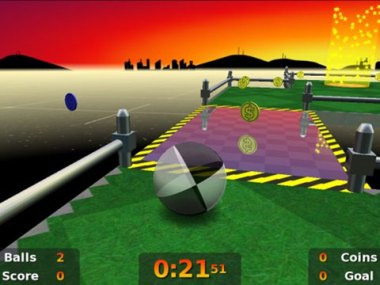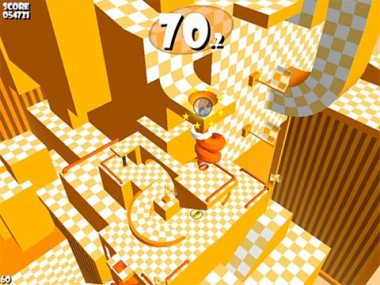While I was busy working on Roll ‘Em Out, it seemed fitting to do some research on any possible clones that might already exist, both for inspiration and to evaluate the competition. I have found four PC games that closely fit this “rolling ball” genre, and here are my reactions after giving each a try. They are Neverball, Hamster Ball Gold, Switchball, and Super Gerball. And this is also why I chose the title that I did for my game, because anything with “ball” in it already sounds overdone and unoriginal. Today I will be talking about Neverball and Hamsterball Gold.

The first game I tried, Neverball, was made by a grad student that actually attended the very same university that I am attending, and around the same concentration of interest (electronic visualization). How awesome is that! Never got to meet him, though, so I just know about him from his brief bio page and an interview he did (You can find more about him on his website, icculus.org).
Now for the game itself. Unlike the other three games, Neverball is completely open-source, allowing for tweakable levels and custom music, and it’s all freeware. Big points already right there! Control is what you’d expect to be for a keyboard and mouse. A lot of people would complain about motion sickness because the levels meander quite often as you move the ball. You get that in the Monkey Ball games too, but at least the movement feels quick and responsive. Neverball’s controls feel floaty and a bit too loose, and it definitely needs getting used to.
Aside from this issue, the levels provide a good challenge and the core game is divided into three levels of difficulty. Due to its open source nature, Neverball has gotten a loyal following and the dev community has made marginal improvements to the game, including new levels and features.
But the presentation is a bit lacking. While clean and simple, this doesn’t have the polish of a full-blown commercial game. Not to say that it’s ugly, but it follows the “if it’s not broken, don’t fix it” mantra- sparse text menus, voices, and simple visuals- it’s all thrown together in a no-nonsense manner that you would expect from an indie game developer. Neverball still gets props from me, as it gives a reasonable learning curve, solid gameplay, and extensive customization from a developer’s point of view.

Some games aren’t what they seem until you play it for yourself, and that’s what I got with Hamsterball Gold. Instead of tilting the level around the ball, you just guide the ball directly with the mouse, as in Marble Madness. The style of play follows that game as well, since all the levels emphasize speed over dexterity, in a mad race to get through an obstacle course in the shortest time possible.
This is a more polished, commercialized shareware game and it shows. The levels are very colorful and have some sort of theme to them, at least presented in a more illustrative manner than Neverball. And unlike Neverball, the music is mostly upbeat as well. The shareware value is acceptable- you can progress through the game until you reach a certain level, where the game freezes in the middle and asks you to buy the game. But the levels you do get to play are still pretty good, and fun to beat your own personal records.
That’s it for now. I’ll continue the reviews in the future, when I’ll be scoping out Switchball and Super Gerball.